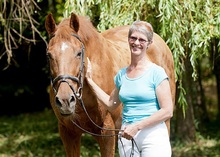Newsdate: Fri 27, Feb 2015 - 9:00 am
Not many of us come to riding with the anatomical understanding of a medical doctor, and so it is often our aids and position are caught somewhere between a mystery and a miracle---we're not sure how or why they work, but we are thrilled when they do!

Dr. Beth Glosten with her horse
While riding can feel magical, being a successful rider does not happen by magic, but riding with the anatomical understanding of a medical doctor helps the typical rider adjust and enjoy the sport.
© 2015 by Trafalgar Books
Dr. Beth Glosten does have that knowledge of the human body and how it functions, and she found that it was integral to her progress as a rider when she came back to horses after years away to pursue her medical degree and residencies.
In Dr. Glosten's flat-out fantastic book The Riding Doctor, she provides clear, practical explanations of the realities of the human body and how it can be trained to accommodate the shape and movement of the horse, as well as the skills necessary in all riding sports.
More than 50 easy-to-do exercises help develop fitness and mechanics specific to riding. It has been described as "a more technical, practical Centered Riding...sort of Centered Riding for the rest of us" and "a wonderful resource."
We recently caught up with Dr. Glosten before her busy season of teaching and clinics begins and asked her a little about her path from "Doctor Doctor" to "Riding Doctor," as well as how she hopes her book will help other riders in their own journeys.
TSB: How did being a medical doctor impact your pursuit of riding and eventually dressage?
BG: I was hooked on horses and riding before going to medical school. Horses were not a part of my life during my medical education, and I wasnât sure at that time that they would be a part of my life again, I was so busy and consumed by my training. It wasnât until I started to have some time for myself, after medical school and residency training, that the idea of riding again entered my mind.
While I did do some jumping when I got back into riding, dressage proved to be the perfect fit. It matches my detail-oriented, perfection-seeking mind! While a practicing physician, I was an Anesthesiologistâagain, a detail-oriented professionâand one would hope every Anesthesiologist seeks perfection in their practice!
TSB: How do you feel your medical career helps your riding and the riding of your students?
BG: Understanding a bit of anatomy helps me solve my riding position problems and the horseâs training problems. While riding can feel magical, being successful does not happen by magic. I believe that wonderful feeling of riding in harmony comes from thoughtful consideration of what is going on. There is a great deal of this kind of problem-solving in medicine.
Many of my clients come to me because of prior injuries or pain issues while they ride. My medical education helps me understand their problems and hopefully pin down movement or riding habits that could contribute to their problem. My own history of injuries, I hope, helps me approach the issues that my clients have with compassion and patienceâat least this is my goal!
You can read the complete interview with Dr. Glosten at: http://horseandriderbooks.wordpress.com.
